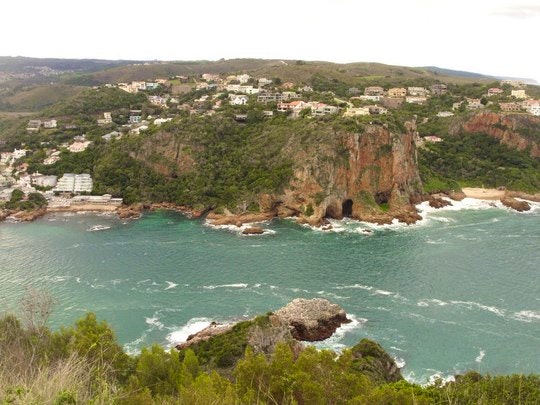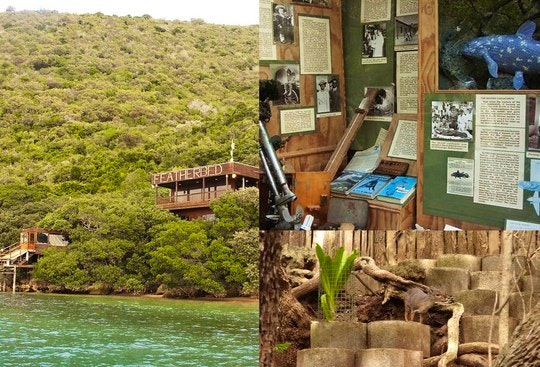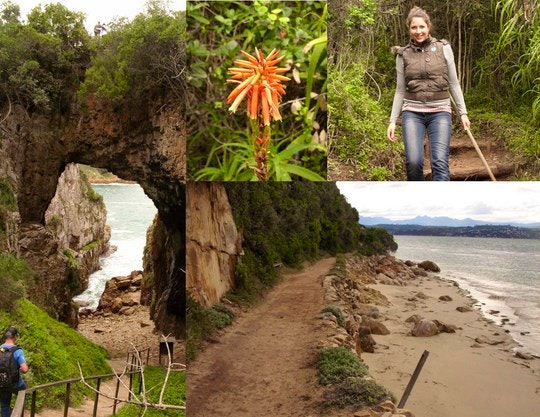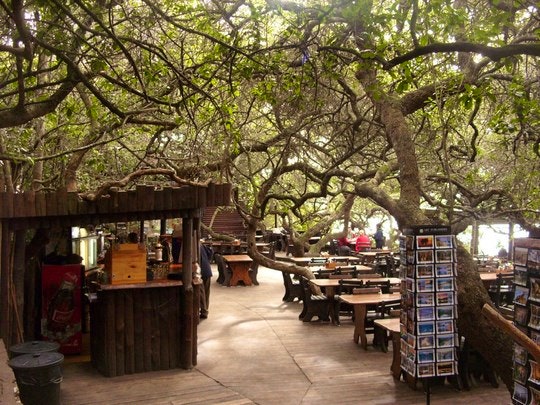The first thing you notice about Knysna is its brazen natural beauty. It’s not subtle at all. No matter where you turn, Mother Nature boasts some of her finest works of art in the form of meandering waterways, golden beach sands, enchanting forests, waves of green hills, and rugged sandstone cliffs. The other thing you notice (especially at night) is that only one of the legendary Knysna Heads dazzles in the light of luxury mansions. The Western Head on the other hand remains virtually untouched; the silent sister who sleeps in darkness and shines her beauty during the day.
Knysna’s Western Head is home to Featherbed, a privately-owned nature reserve and South African Heritage Site that captures the essence of Knysna’s beauty. The reserve is only accessible by ferry and to protect its natural splendour, only a limited number of people are able to visit each day – in the company of a specialist guide.
Our 4-hour eco-experience began on a shaded open ferry called the Three Legs Rivercat. Despite gloomy conditions, the trip across the lagoon (which, perfectionists will tell you, is actually an estuary) was peaceful and refreshing as we passed anchored boats in the bay and affluent homes on the shore. Our sharp-witted guide, Oliver, had us in hysterics as he departed interesting facts about the history of Knysna. Did you know it is the 3rd oldest harbour in South Africa and the 2nd largest wetland in southern Africa? We also learned that Featherbed derived its name from sailors who cast anchor into the tranquil bay waters to enjoy what felt like “sleeping on a feather bed”. But the most fascinating fact of the day was how Featherbed came to be. In 1938, a strange fish was found off the east coast of South Africa. Fish expert, Prof. J L B Smith identified it as the Coelacanth, which was thought to be extinct for over 70 million years. Prof. Smith wrote a series of books on his discoveries and, with the proceeds, bought the land at Featherbed. When he passed away, he left the land to his son, William Smith, who many South Africans will recognise as “The Maths Man” on TV.
When we docked at Featherbed, I was immediately enamoured by the Forest Restaurant; a rustic wooden deck under a canopy of Milkwood trees. There was also an exhibit documenting Prof. Smith’s obsession with the Coelacanth. This is where we would finish off our journey, but first we had to work up an appetite! Our group hopped into the 4×4 vehicle and the string of trailers that followed behind, and drove up the steep incline to the top of the headland where we were treated to the most sensational views over the Indian Ocean, sprawling lagoon and town, and fading mountains on the horizon.
What followed was an optional guided 2,2km walk (suitable for all ages and fitness levels) through the coastal forest and fynbos. We had been offered walking sticks, but in retrospect, I would have declined. The walk is about 90% downhill and I spent far too much energy resisting the urge to play Star Wars and figuring out the most comfortable way to carry the stick. We snapped plenty photos at another elevated viewpoint before descending, over bridges of weathered rock, into ancient Khoi San sea caves that gaped along the jagged shoreline. From here we trailed along a scenic coastal path fringed with aromatic (at times rather pungent) fynbos. By this stage we’d lost the group (some had gone ahead and others trailed behind) and were free to enjoy the remote setting.
Upon returning to the restaurant, we passed an enclosure of the rare Blue Duiker – one of the smallest antelope species in the world, standing roughly 30cm tall. Featherbed is home to a breeding program for the Blue Duiker, the beautiful Knysna Loerie, and the endangered Knysna Sea Horse. During the coastal walk, you also have a chance of spotting the Black African Oyster Catcher, one of South Africa’s rarest coastal birds.
After browsing through the curio shop, we sat down to indulge in a sumptuous buffet lunch. The rain set in, but we barely felt a drop through the thick canopy of trees and continued to enjoy a relaxing meal outdoors. It’s nice to know that, even if you aren’t on an eco-experience tour, you can still visit Featherbed’s beach bar area on your own boat – I’m told it’s a popular spot in the summer and the calamari dish is a local favourite!
The temptation to set up camp and call Featherbed my own was overwhelming, and I reckon similar thoughts have crossed thousands of well-meaning minds. It must be when you’re surrounded by such magnificent natural beauty, and want so much more of it, that you begin to realise how important it is to leave it alone. Featherbed is an exceptional eco-experience where people of all ages can learn to appreciate nature at its finest.
What eco-experience do you recommend?








